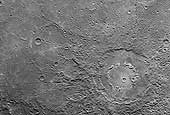|
COMETS EARTH JUPITER KUIPER BELT MARS MERCURY METEORITES NEPTUNE OORT CLOUD PLUTO SATURN SOLAR SYSTEM SPACE SUN URANUS VENUS ORDER PRINTS
PHOTO CATEGORIES SCIENCEVIEWS AMERICAN INDIAN AMPHIBIANS BIRDS BUGS FINE ART FOSSILS THE ISLANDS HISTORICAL PHOTOS MAMMALS OTHER PARKS PLANTS RELIGIOUS REPTILES SCIENCEVIEWS PRINTS
|
Related Documents
Download Options
This scene was imaged by MESSENGER's Narrow Angle Camera (NAC) on the Mercury Dual Imaging System (MDIS) during the spacecraft's flyby of Mercury on January 14, 2008. The scene is part of a mosaic that covers a portion of the hemisphere not viewed by Mariner 10 during any of its three flybys (1974-1975). The surface of Mercury is revealed at a resolution of about 250 meters/pixel (about 820 feet/pixel). For this image, the Sun is illuminating the scene from the top and north is to the left. The outer diameter of the large double ring crater at the center of the scene is about 260 km (about 160 miles). The crater appears to be filled with smooth plains material that may be volcanic in nature. Multiple chains of smaller secondary craters are also seen extending radially outward from the double ring crater. Double or multiple rings form in craters with very large diameters, often referred to as impact basins. On Mercury, double ring basins begin to form when the crater diameter exceeds about 200 km (about 125 miles); at such an onset diameter the inner rings are typically low, partial, or discontinuous. The transition diameter at which craters begin to form rings is not the same on all bodies and, although it depends primarily on the surface gravity of the planet or moon, the transition diameter can also reveal important information about the physical characteristics of surface materials. Studying impact craters, such as this one, in the more than 1200 images returned from this flyby will provide clues to the physical properties of Mercury's surface and its geological history. Credit: NASA/Johns Hopkins University Applied Physics Laboratory/Carnegie Institution of Washington |
